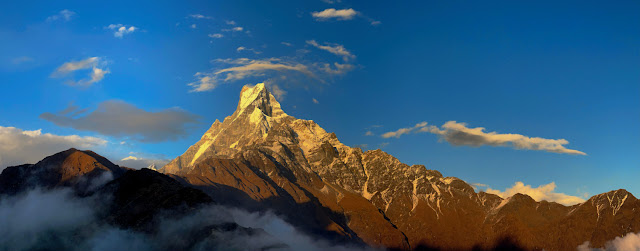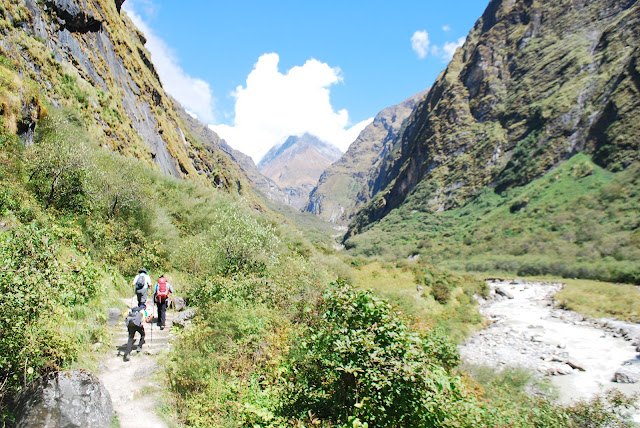Embarking on a trek to Everest Base Camp is not just any adventure—it's the journey of a lifetime that draws hikers from all corners of the globe. Nestled amidst the towering peaks of Nepal, this trek offers unparalleled views of the world's highest mountain, Mount Everest, and gives you a profound appreciation for the majesty of nature. Whether you're a seasoned trekker or it's your first time strapping on hiking boots, the path to Everest Base Camp is filled with breathtaking landscapes, vibrant Sherpa culture, and unforgettable experiences. Before you lace up your boots and hit the trail, there are a few things you'll need to know. Preparation is key, and this guide is designed to give you all the information you need to make your trek successful and enjoyable. From choosing the best route to packing the essentials, we've got you covered. Let's get started on the journey that awaits you in the heart of Nepal.
Choosing the Right Route
Choosing the right route for your Everest Base Camp (EBC) trek is like picking the perfect trail map for an unforgettable adventure. The route you choose not only shapes your trekking experience but also challenges and rewards you in unique ways. Let’s dive into the options and factors that influence your decision.
Popular Routes to Everest Base Camp
The journey to Everest Base Camp has several paths, but two stand out for their popularity and scenic allure:
- The Classic Route: Also known as the Standard Route, it starts in Lukla and takes you through villages like Namche Bazaar, Tengboche, and Dingboche. It’s a favorite for its rich cultural exposure and stunning views of the Himalayas. This trek typically lasts about 12 to 14 days.
- The Gokyo Lakes Route: For those seeking a path less trodden, the Gokyo Lakes Route offers an alternative. It diverges from the Classic Route at Namche Bazaar, taking trekkers through the mesmerizing Gokyo Valley and over the Cho La Pass before rejoining the main trail near Lobuche. This option adds a few days to your itinerary but rewards with less crowded paths and the breathtaking beauty of the Gokyo Lakes.
Factors to Consider When Choosing a Route
When selecting your path to Everest Base Camp, consider the following:
- Duration and Schedule: Make sure the route you pick fits within your available time frame. Remember, more remote or challenging routes may require extra days.
- Physical Fitness and Trekking Experience: Assess your fitness level and trekking experience. If you’re a beginner, the Classic Route might be more suitable.
- Desire for Scenery and Culture: Think about what you want to see and experience. If cultural immersion is a priority, the Classic Route offers plenty of opportunities. For stunning natural landscapes and quieter paths, consider the Gokyo Lakes Route.
- Budget: Keep in mind that some routes may have additional costs, such as extra permits or guide services.
Essential Tips for a Successful Trek
Achieving the dream of reaching Everest Base Camp requires more than just enthusiasm. Here are some essential tips to help ensure a successful trek.
Physical Training and Fitness
Physical preparation cannot be overstated. Start training at least six months before your trek. Focus on:
- Cardiovascular Exercises: Running, cycling, and swimming improve stamina.
- Strength Training: Work on your legs, back, and core to handle the rigorous trekking demands.
- Hiking Practice: If possible, practice hiking on varied terrains and inclines.
Acclimatization and Altitude Sickness Prevention
Altitude sickness can affect anyone, regardless of fitness levels. To prevent it:
- Ascend Slowly: Give your body time to adjust to the altitude. Plan for acclimatization days in your itinerary.
- Stay Hydrated: Drink at least 3-4 liters of water daily to help the body acclimatize.
- Recognize Symptoms: Be aware of altitude sickness symptoms such as headache, nausea, and dizziness. If symptoms persist or worsen, descend immediately.
Incorporating these strategies into your preparation and choosing the right route will not only make your trek to Everest Base Camp more enjoyable but also safer and more rewarding. Remember, the journey is as significant as the destination itself.
Gear Preparation
When venturing on the epic journey to Everest Base Camp, preparing the right gear is as crucial as your physical fitness. The unpredictable mountain weather and the rugged terrain demand high-quality gear. It's not just about comfort; it's about safety and ensuring your trek is a memorable adventure for all the right reasons.
Clothing and Footwear Essentials
The key to staying comfortable is layering. Your clothing selection should be versatile, allowing you to adapt to rapid weather changes. Firstly, invest in a good-quality, breathable base layer that wicks away moisture. Your second layer should provide insulation, while the outer layer must be waterproof and windproof. Don’t forget a warm hat, gloves, and thermal underwear for the chilly evenings.
Footwear is arguably the most critical component of your trekking attire. A sturdy pair of waterproof trekking boots that have been broken in is essential to avoid blisters and discomfort. Pair these boots with moisture-wicking socks and consider gaiters for extra protection against mud and rain.
Trekking Equipment Checklist
- Backpack (with a rain cover)
- Sleeping bag (rated for -10°C to -20°C)
- Trekking poles
- Headlamp and batteries
- Water purification tablets or a portable water filter
- Sunglasses and sunscreen
- First-aid kit including blister care
- Lightweight, quick-dry towels
Remember, every gram counts. Opt for lightweight, durable items that serve multiple purposes if possible.
Packing and Logistics
Preparation extends beyond just what you pack. How you pack and manage your logistics plays a pivotal role in the trekking experience. The right strategy can make your journey smoother and more enjoyable.
Packing Tips and Tricks
Packing smartly begins with selecting a comfortable, durable backpack. Aim for a 50-65 liter capacity for sufficient space. Utilize packing cubes or bags to organize your items categorically – clothes, toiletries, electronics, and medical supplies. This not only saves time but also keeps your gear dry and secure. Compression bags can be a lifesaver for bulky items like sleeping bags and jackets, reducing them to manageable sizes.
Always pack keeping in mind the principle of accessibility. Items that you need frequently, like water, snacks, sunscreen, and your camera, should be easily reachable. Lastly, a rain cover for your backpack is a must to safeguard your belongings from sudden downpours.
Hiring a Guide or Porter
While many seasoned trekkers choose to undertake the Everest Base Camp trek independently, hiring a guide or a porter can greatly enhance your experience. A guide not only navigates the trail but also enriches your journey with local insights into the culture and natural beauty of the region. They can be instrumental in dealing with emergencies and ensuring your safety.
Porters, on the other hand, can alleviate the physical strain by carrying your main backpack, allowing you to focus on the stunning vistas and the thrilling hike. If you’re considering this option, make sure to hire through reputable companies, and remember, ethical treatment and fair payment of your porter or guide are paramount.
By thoroughly preparing your gear, packing wisely, and considering the logistics with care, you set the stage for an unforgettable Everest Base Camp trek. Remember, the right preparation not only makes your journey safer but also more enjoyable, allowing you to fully immerse in the awe-inspiring beauty of the Himalayas.
Safety and Health Considerations
Embarking on an adventure to Everest Base Camp is thrilling, but your safety and health should always come first. The high altitudes and rugged terrains pose unique challenges, making it essential to plan meticulously for any unforeseen circumstances. Remember, being well-prepared is your first step to a successful and enjoyable trek.
Travel Insurance and Permits
Before setting out on this adventure, ensure you have comprehensive travel insurance that covers high-altitude trekking up to 5,500 meters (18,044 ft) - the altitude of Everest Base Camp. Look for policies that include emergency medical evacuation and repatriation, just in case. It’s not just about being cautious; it’s a necessity given the remote and challenging nature of the trek.
Additionally, you’ll need a few permits to trek in the Everest region: the TIMS (Trekker's Information Management System) card and the Sagarmatha National Park permit. These can usually be arranged by your tour company if you’re going with one, or you can acquire them in Kathmandu or Lukla if you’re organizing the trek independently.
First Aid Kit and Medications
A comprehensive first aid kit is your best friend on the mountain. Include basics such as band-aids, antiseptic cream, blister plasters, and bandages. Also, pack medications for common issues like headaches, stomach upsets, colds, and sore throats. Altitude sickness is a serious concern, so carry Diamox (acetazolamide) unless contraindicated for you, and always consult your doctor before your trip for advice tailored to your medical history.
Don’t forget to take sun protection seriously. The UV rays at high altitudes can be surprisingly strong, so pack a high SPF sunscreen, lip balm with sun protection, and a quality pair of UV-protectant sunglasses.
Cultural Etiquette and Respect

Image courtesy: Unsplash
Trekking to Everest Base Camp is not just an adventure; it’s a journey through the heart of Nepalese culture. As you pass through remote villages and ancient monasteries, understanding and respecting the local customs and traditions will enrich your experience immeasurably.
Interacting with Locals
Nepalese people are known for their friendliness and hospitality. A warm “Namaste” as a greeting is much appreciated. While English is commonly spoken in tourist areas, learning a few basic phrases in Nepali can go a long way in connecting with locals.
When taking photos, always ask for permission first, as some people may not feel comfortable being photographed. Additionally, dress modestly, especially when visiting monasteries or temples, to show respect for local customs.
Preserving the Environment
The Everest region's beauty is timeless, and it’s up to every trekker to help keep it that way. Practice “Leave No Trace” principles by carrying out all your trash, including biodegradable items. Use water purification methods rather than buying bottled water to minimize plastic waste.
Respect wildlife by keeping a safe distance and not feeding the animals. When it comes to firewood, be aware that it’s a scarce resource for locals, so opt for places that use sustainable energy sources like solar power.
By following these guidelines on safety, health, and cultural etiquette, your Everest Base Camp trek will not only be an unforgettable adventure but also a journey carried out with respect and care for the local community and environment.
Conclusion: Your Epic Everest Base Camp Adventure Begins!
Embarking on the Everest Base Camp trek is a journey like no other. It’s not just a trek; it's an adventure that tests your limits, exposes you to breathtaking landscapes, and immerses you in the rich culture of Nepal. With the right preparation, the best routes in mind, and essential tips at your fingertips, you're all set to make this experience not just memorable but truly life-changing.
- Prepare thoroughly by training physically and gathering all necessary gear.
- Choose your route wisely, keeping your experience and comfort level in mind.
- Learn about Nepalese culture to enrich your journey and connect with the local communities.
Remember, the Everest Base Camp trek isn't just about reaching a destination; it's about the journey, the people you meet, the challenges you overcome, and the memories you create. Whether you're a seasoned hiker or a first-time trekker, this guide is designed to help you navigate your Everest quest with confidence.
Now, it's your turn to lace up your boots, set your sights on the horizons of Nepal, and start an expedition that promises not just views of the world's tallest peaks but a profound journey inward. Safe travels, and may your Everest Base Camp adventure be everything you've dreamed of and more!




